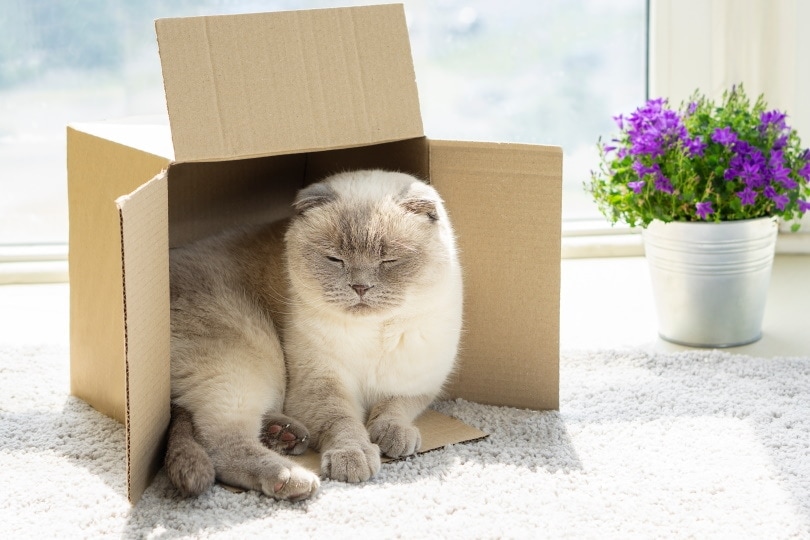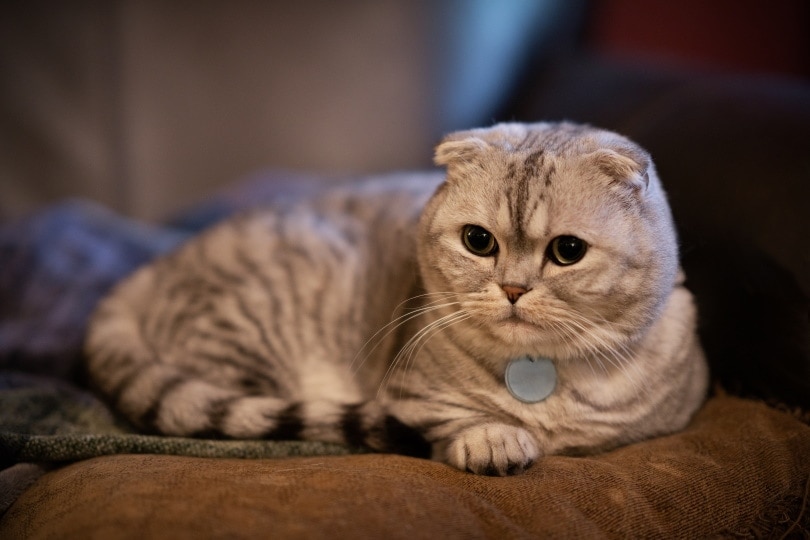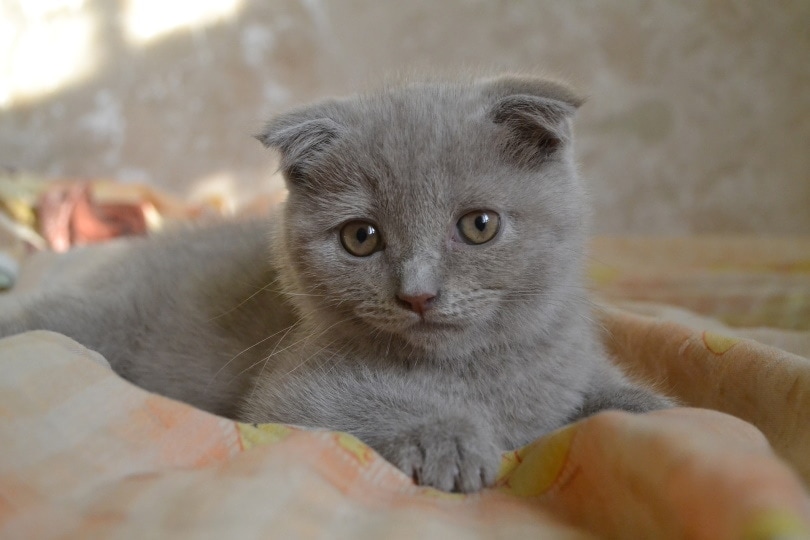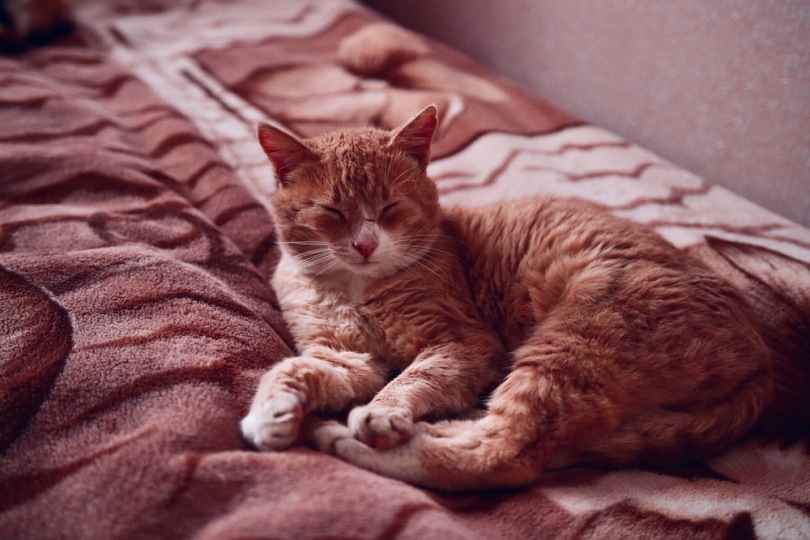How Long Do Scottish Folds Live? Average Lifespan, Data & Care

Updated on

Click to Skip Ahead
Scottish Folds are smart, loving, and social cats, and as their name suggests, they originated in Scotland. They’re unusual because, unlike most breeds, the history of the Scottish Fold is well-documented and involves a cat named Susie. Susie was a barn cat who spent her time hunting down mice, and her folded ears brought her to the attention of a shepherd who acquired one of her kittens and called it Snooks.
Snooks also had kittens, and one of the males was bred with a British Shorthair to create the Scottish Fold breed.
Scottish Folds live around 11 to 15 years on average. But unfortunately, the genetic mutation associated with their cute, folded ears also leads to some health issues. So, what makes one Scottish Fold less healthy than another? And what has breeding done to this cat’s genetic makeup?
What’s the Average Lifespan of a Scottish Fold?
The average lifespan of a Scottish Fold is around 11–15 years old, but this number is, of course, affected by a variety of factors like your cat’s living environment, their exercise routine, and if they suffer from any pre-existing conditions.

Why Do Some Scottish Folds Live Longer Than Others?
There are several factors at work that you need to juggle as a pet parent to ensure your pet is happy and healthy. We will examine what influences the lifespan of the Scottish Fold.
1. Health Conditions
We’ve started with health conditions because Scottish Folds are prone to some that will affect other aspects of their life, like their diet. Scottish Folds are susceptible to Osteochondrodysplasia, which is linked to the very thing they were bred for: their folded ears. As a result, they are also more prone to arthritis and obesity because if they are in pain, they won’t be as motivated to exercise as a healthy cat would.
So, what exactly is Osteochondrodysplasia? This disorder is characterized by abnormal development of cartilage and bone. Unfortunately, it’s incurable and excruciating.
It can usually be treated with medication and, in extreme cases, surgery, but as there is no cure, treatment will continue throughout your cat’s life. Generally, common health issues can be screened for, but Osteochondrodysplasia is unavoidable for Scottish Fold cats with folded ears and can develop in kittens as young as 7 weeks old.
Interestingly, Scottish Folds aren’t recognized as a breed in Scotland because of concerns about the risk of ear infections and deafness.

2. Environment and Housing
Scottish Folds are known for being easygoing and sociable, and they usually get along well with other cats or dogs and adapt well to multi-pet households. This affectionate cat will do well in most homes, and they like children.
If your Scottish Fold develops Osteochondrodysplasia or arthritis, you will need to think about their environment and how you can make their lives easier. Items like easy-access litter boxes and low cat trees will help.
3. Nutrition
The Scottish Fold will require the same diet as any cat that needs to focus on weight control, as obesity will put an extra strain on their joints and bones, and it can also lead to diabetes. Obesity can shorten your cat’s life, so you should consult your veterinarian for nutritional recommendations as your cat ages and their needs potentially change.

4. Exercise
If your cat develops Osteochondrodysplasia, it might be in pain, so it won’t come as much of a surprise that it isn’t the most active cat. It will be your job to encourage movement to keep them healthy. Get some toys and puzzles which will keep your cat’s mind and body active and strengthen your bond with one another.
5. Breeding History
There are two types of Scottish Fold cats: one with folded ears and another with straight ears. The latter is the relatively healthy version.
Scottish Fold cats are a controversial breed. Fédération Internationale Féline has banned them, and they have also been removed as a registered breed by the Cat Fancy of Great Britain.
Breeders in the United States have also attempted to breed out their health problems by breeding them with American and British Shorthairs, but as this gene is dominant, some resulting kittens can have folded ears. So, while some cats can live to their full potential and lead healthy, happy lives, others live in pain or are euthanized early.
6. Healthcare
Scottish Folds have dense fur that requires weekly brushing. Be careful with their tail as they commonly have a stiff tail that might be painful when pulled or bent. It’s also a good idea to keep their nails trimmed. This is helpful for mobility as well as comfort. The folds in their ears can make these cats more prone to ear infections because of the decreased airflow. So regularly check them for signs of mites, infections, and irritation.
7. Family Life
The Scottish Fold is affectionate and calm and does well with families that are the same. While they are good with children, they aren’t fond of rough play. They are moderately active and do best indoors.
They’re an intelligent breed and can be taught to bring toys back when called, and they can also learn to walk on a leash. They aren’t overly vocal and are considered easy to live with.

The 3 Life Stages of a Scottish Fold
It takes about 18 months for a Scottish Fold to reach maturity, which is considered quicker than other cat breeds, like British Shorthairs or Siberians.
1. Kitten and Young Adult
All Scottish Fold kittens are born with straight ears, but the fold will likely appear around 3 weeks of age. Your cat will need a high-quality, balanced diet to promote the healthy growth of muscles, strong bones, and a healthy heart.

2. Mature Adult
Scottish Folds grow up to 10 to 30 inches in length and can weigh between 5 and 11 pounds once they reach full maturity. As they are only moderately active and prefer time spent indoors, you will need to encourage exercise or train them to walk on a leash to get them outside.
3. Senior
As your Scottish Fold ages, they will inevitably slow down, and the risk of putting on weight increases. Your cat will still require high-quality protein sources from its diet, easy-to-digest carbohydrates, and controlled fat levels. If you’re concerned about their weight, talk to your vet for advice.

 How to Tell Your Scottish Fold’s Age
How to Tell Your Scottish Fold’s Age
Some owners celebrate their cats’ birthdays, but those who adopt adult cats have to estimate their pet’s ages. There are, however, ways to figure out your cat’s age.
It’s important to note that when your cat is prone to health risks, it can make the following indicators less reliable.
1. Size of the Kitten
Until cats are 4 to 6 months old, they’ll gain a pound every month. So, a 3-pound kitten is 3 months old, and so on. Of course, this isn’t a foolproof method. If your cat has a health problem, their weight can’t be used as a reliable age indicator.
2. Health of the Eyes
Healthy kittens and young cats usually have bright, clear eyes, while older cats develop a cloudy appearance. This doesn’t usually happen until your cat is around 10 years old, and cats beyond this age will also show changes in their irises. They might develop a wavy edge or not open and close when exposed to light.

3. Teeth
The size of your cat’s teeth is helpful in working out their age. An older cat’s teeth will generally show some wear and tear. If it’s a kitten, you can use how many baby teeth or deciduous teeth it has as an indicator of age. These baby teeth usually come in when your Scottish Fold is 2 weeks old and finish when they’re 8 weeks old.
Around 4 months of age, the baby teeth will begin to fall out, and the adult teeth will take their place. When your cat is 7 months old, it should have all its adult teeth. However, after this point, it’s more difficult to tell how old the cat is.
4. Observe Grooming Habits
Many factors can change the way a cat grooms itself. If your Scottish Fold is in pain, it might not be able to reach to groom itself properly. Dental issues that cause pain can also stop your cat from grooming. An older cat may not groom as thoroughly as a younger cat, which is why this is sometimes used to narrow down a cat’s age.
 Conclusion
Conclusion
Scottish Folds have an unusual history because we have an origin story for the adorable cats. While they can live long and healthy lives, some cats’ lives are blighted by pain, so even though their lifespan is long, it sits in a morally grey area.
There are ways to make your cat if it suffers from health issues, such as investing in specialized diets, making their environments accessible, and working with your vet to find the right treatment plan.
See Also:
Featured Image Credit: Oleksandr Volchanskyi, Shutterstock











